Creative Bathroom Lighting Ideas for Your Space
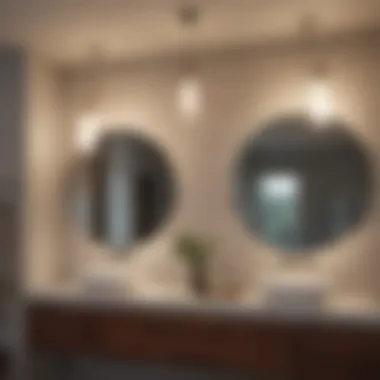
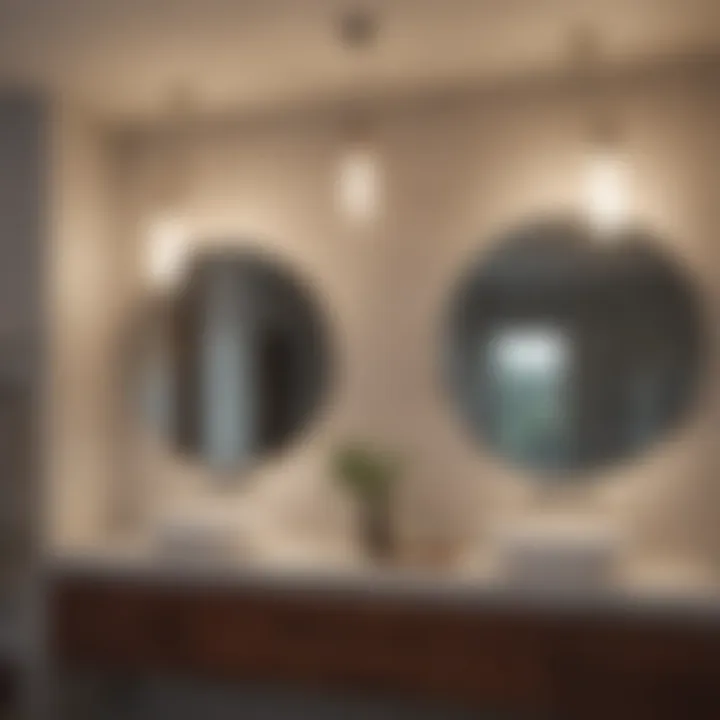
Intro
The bathroom often serves as a retreat from the chaos of the day, a personal sanctuary where one can unwind and rejuvenate. As such, the right lighting plays a crucial role in crafting this tranquil atmosphere, influencing both mood and functionality. An array of choices exists, and navigating these can feel overwhelming. But fear not—whether you’re after a modern touch or something that brings old-world charm, integrating the right lighting ideas can transform your bathroom into an aesthetically pleasing space.
Design Inspirations
Great design often starts with inspiration. Understanding the current trends can provide valuable guidance. From sleek, minimalistic styles to warm, rustic vibes, the possibilities are endless. By focusing on trending styles and suitable color palettes, homeowners can create an inviting atmosphere that resonates with their personality and lifestyle.
Trending Styles
When it comes to bathroom lighting, it’s essential to keep pace with what’s currently in vogue. Some popular trends include:
- Industrial Flair: Exposed bulbs and metallic finishes add an urban edge, ideal for those who appreciate a touch of the unconventional.
- Nature-Inspired: Wooden elements paired with soft whites can evoke a serene forest ambiance, perfect for relaxation.
- Art Deco Elegance: Geometric shapes and luxurious materials create a sense of vintage charm.
- Smart Lighting Solutions: With technology integration, homeowners can adjust brightness and color temperatures, tailoring the mood to specific times of the day.
Each of these styles not only serves a functional purpose but also enhances the overall aesthetic, making your bathroom feel more like a sanctuary.
Color Palettes
Color can significantly influence the ambiance of a space. Here are some color schemes to consider when choosing lighting for your bathroom:
- Soft Neutrals: Whites and creams can create an understated elegance, allowing natural light to reflect and enhance the feeling of space.
- Earthy Tones: Greens and browns can foster a connection to nature, contributing to a calming environment.
- Bold Accents: Using darker hues for fixtures can add contrast and depth, turning functionality into a focal point.
- Pastels for Serenity: Colors like soft pinks or blues bring a gentle touch, perfect for creating a tranquil retreat.
Exploring these color palettes can help balance the lighting with the overall decor, creating a harmonious look that feels curated.
"Effective bathroom lighting combines style with utility, improving both the aesthetic and the experience of the space."
Product Recommendations
With an understanding of design inspirations, it’s time to look at specific products that can elevate your bathroom lighting. Choosing the right accessories and essentials can make all the difference.
Bath Accessories
Consider incorporating:
- Wall Sconces: These can flank mirrors to provide adequate lighting without taking up counter space.
- LED Mirrors: Functional yet stylish, these mirrors radiate a soft glow that enhances tasks like shaving or applying makeup.
- Ceiling Fixtures: A statement chandelier can serve as a central point, combining beauty and illumination.
Bedroom Essentials
While the bathroom and bedroom are separate, lighting choices that work together can enhance the overall flow of your home. Ideas include:
- Recessed Lighting: This provides a seamless look, allowing for an unencumbered view while offering sufficient illumination.
- Dimmer Switches: Ideal for creating varying moods during the day and night.
By thoughtfully selecting products that align with your chosen designs and color schemes, creating a space you love is well within reach.
Setting the Scene with Bathroom Lighting
Creating a mood in your bathroom through lighting is like setting the tone for a grand piano concert; it can either leave you in a state of awe or just humming along. Bathroom lighting isn’t just an afterthought; it truly shapes the entire atmosphere of the space. When you walk into a bathroom, your immediate perception is influenced by how well the light interacts with the walls, fixtures, and even your own visage when you catch a glimpse in the mirror. It’s vital that homeowners pay respect to this, for it can transform an ordinary bathroom into a serene retreat, or unfortunately, it might lead to a lackluster experience.
Appropriately designed lighting not only enhances aesthetics but also boosts functionality. Imagine taking a relaxing soak in the tub, surrounded by soft, warm light, or preparing for your day under bright task lighting that brings out every detail. This is not just about visibility; it’s about experience. Proper lighting can help in defining various zones in your bathroom, guiding you on how to interact with the space.
While selecting the right lighting, there are a multitude of elements to consider — from the size of the bathroom and its layout to the fixtures that marry well with your style and preferences. In the end, it all boils down to one fundamental principle: lighting should elevate your daily rituals rather than complicate them.
Importance of Lighting in Bathroom Design
Embarking on a bathroom design project without considering lighting is akin to baking a cake without the sugar; it can fall flat. Natural and artificial light work hand-in-hand to set the mood and allow a space to breathe. Good lighting minimizes harsh shadows that can make tasks like shaving or makeup application tricky. Also, it maximizes the perception of space. A dimly lit area can feel cramped, whereas a well-lit bathroom appears more open and inviting, even if square footage is limited.
Furthermore, it's essential for safety. Mismatched lighting can lead to accidents, especially in a space where water meets electricity. Therefore, task lighting placed around sinks or vanities is highly recommended. All in all, proper lighting is indispensable for blending style with safety and practicality.
Understanding Different Lighting Types
Ambient Lighting
Ambient lighting lays the groundwork for illumination within any bathroom. It creates a general, even glow that fills the entire space, often acting as the primary light source. This is where ceiling-mounted fixtures, like flush mounts or chandeliers, come into play. What makes ambient lighting compelling is its ability to envelop the room with a warm, inviting aura.
This type of lighting is a beneficial option because it allows for comfortable movement without the glaring brightness that feels intrusive. However, one must recognize that too much ambient light can make the space feel flat. It often lacks contrast, which can somewhat dull the aesthetic charm you’re aiming for. Striking a balance between ambient and task lighting can yield a beautifully harmonized atmosphere.
Task Lighting
Where ambient lighting provides a broad glow, task lighting is the spotlight in your bathroom setup. This type of lighting focuses on specific areas where detailed work takes place, such as the sink, shower, or bathtub. Wall sconces flanking mirrors or adjustable shower lights can be functional and stylish additions for addressing these critical zones.
The advantage of task lighting lies in its ability to produce bright, clear light that helps in executing careful tasks like grooming or reading labels. However, a note of caution: if overly harsh, it can create unflattering shadows that might detract from your natural beauty. Finding fixtures that offer flattering and adjustable light is essential for achieving that ideal balance.
Accent Lighting
Now we arrive at accent lighting — the cherry on top of your bathroom ambiance. This lighting is typically used to highlight specific features, such as artwork, architectural details, or even decorative plants. Spotlights or recessed lights are popular choices that can create an alluring atmosphere.
Its primary characteristic is its ability to draw attention and create a mood, making it an excellent choice for personalizing the space. The unique feature of accent lighting is its strategic placement, drawing the eye toward certain focal points. The downside lies in its consumption; relying too heavily on accent lighting alone can leave other areas dull and neglected. Balancing accent lighting with other types will ensure the whole space shines in its best light.
Selecting the Right Fixtures
Finding the perfect lighting fixtures for your bathroom is more than just plucking something off the shelf. It's about creating a harmonious blend of style and functionality. Think of fixtures as the jewels in the crown of your bathroom sanctuary. The right selection can bring life to an otherwise dreary space, transforming it into a haven where you enjoy those little moments of peace.
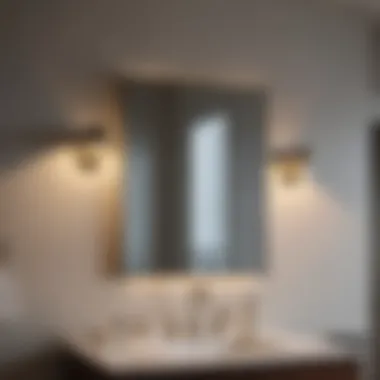
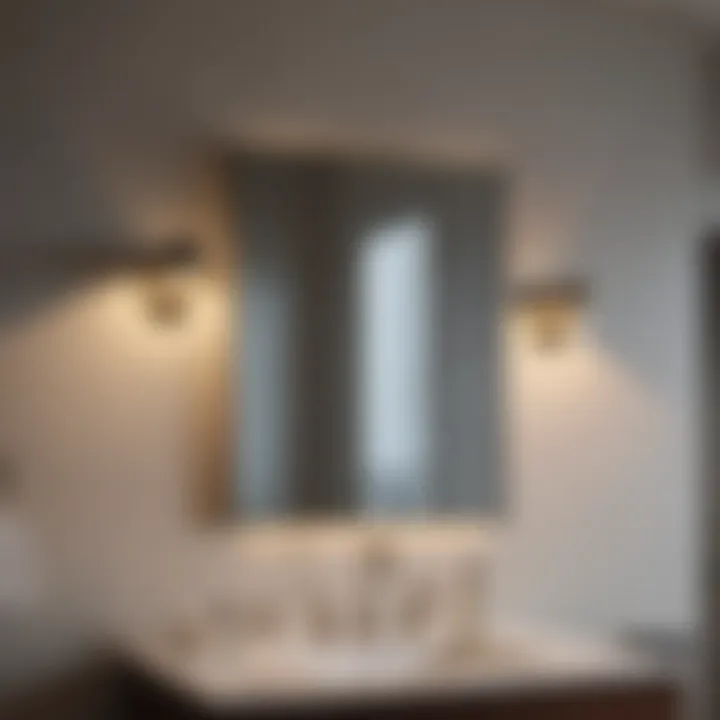
Several key considerations come into play when settling on lighting fixtures. First off, it's not just about how they look. You'll want to evaluate factors such as the intensity of light, how it complements existing decor, and its adequacy for specific functions. Each kind of fixture serves a distinct purpose, and it’s crucial to understand those roles while choosing to avoid a lighting fiasco.
Overview of Fixture Options
Wall Sconces
Wall sconces are like the stylish sidekicks of your bathroom lighting ensemble. They can be positioned at eye-level, which allows for focused illumination in areas like the mirror and sink. Unlike overhead fixtures, wall sconces create a warm glow that wraps around you, making every moment spent at the vanity feel a touch more special.
Key characteristic: Their versatility. They can be sleek and modern, or ornate and vintage, making them fit any design scheme.
Unique feature: Many sconces allow for adjustable heads, giving you the control to change the direction of light.
Advantages/disadvantages: While beautiful, placement can be a puzzle. Not all bathrooms allow for easy mounting, especially if space is tight or if you have tiles that don’t support weight well.
Ceiling Lights
Ceiling lights are the backbone of any room's illumination, and they hold their own in the bathroom. They offer an extensive spread of light making sure that every corner shines brightly while performing everyday tasks.
Key characteristic: Their broad coverage. A well-placed ceiling fixture lights up the entire area and serves as a foundational lighting layer.
Unique feature: Many ceiling lights today come with dimmable options, allowing you to set the mood.
Advantages/disadvantages: While they provide ample light, they may not create the intimate atmosphere that wall fixtures do. Additionally, in smaller bathrooms with lower ceilings, they can sometimes crowd the space.
Vanity Lights
Vanity lights are especially designed to light up your grooming areas. Whether you’re putting on makeup or getting a fresh shave, these lights can make all the difference.
Key characteristic: Generally mounted above or on either side of mirrors, they tend to cast flattering light that minimizes shadows on your face.
Unique feature: They come in various styles, from minimalist bar lights to layered bulbs, catering to different aesthetic preferences.
Advantages/disadvantages: While they’re essential for task lighting, overusing them might lead to a harsh environment; balancing them with softer ambient lights can harness their full potential.
The Role of Material and Finish
Choosing the right material and finish for your fixtures can heighten both their durability and appearance, ensuring that they're not just functional but also serve as design elements.
Metal Finishes
Metal finishes like brushed nickel or polished chrome can add a modern touch to your bathroom. They resist humidity quite well, making them suitable for such a damp environment.
Key characteristic: Their reflective quality enhances light distribution while contributing to an overall aesthetic appeal.
Unique feature: Metal fixtures can be mixed and matched; so, if you are daring, consider pairing different finishes for a more eclectic look.
Advantages/disadvantages: Whereas they’re great at reflecting light, the downside is the potential for smudges or fingerprints to show up, requiring regular cleaning.
Glass Design
Glass fixtures are stunning and come in a multitude of styles, from frosted to clear. They can soften the light, providing an elegant atmosphere in the bathroom.
Key characteristic: They help diffuse light, preventing harsh glare that might be unpleasant for daily tasks.
Unique feature: Some are intricately designed, acting almost like art pieces.
Advantages/disadvantages: However, they may require more upkeep, as glass tends to show dust and water spots rather easily.
Natural Materials
Natural materials like wood or stone can bring an organic element to your bathroom. They evoke a sense of tranquility that aligns well with creating a personal sanctuary.
Key characteristic: Their uniqueness, often with irregular patterns that can be soothing.
Unique feature: Fixtures can reflect the natural environment, enhancing a retreat-like feel in your space.
Advantages/disadvantages: While they may boast beautiful charm, they might not fare well in a high-moisture environment, requiring additional care and maintenance.
Whether you lean towards the sleek lines of modern lighting or the woven intricacies of natural elements, selecting the right fixtures is pivotal for defining the essence of your bathroom sanctuary. A proper combination can turn a bathroom into a feeling of rejuvenation, making every visit a moment to savor.
Designing with Natural Light
Incorporating natural light into your bathroom design isn’t just about aesthetics; it's about creating a space that feels open and inviting. A bathroom bathed in sunlight can lift spirits and enhance the overall atmosphere. When it comes to crafting a sanctuary, daylight plays a crucial role in influencing both the mood and functionality of your space. The natural light exposure can even help reduce energy costs, as it diminishes the need for artificial lighting during the day. However, designing with natural light entails more than just having a window or two; careful consideration of placement, size, and surrounding elements can lead to a significant transformation.
Incorporating Windows
When it comes to making the most of natural light, windows are a game-changer. Not all windows are created equal, and how you position them can dramatically affect the light quality in your bathroom. Consider the size and orientation of the window. A larger window facing east will capture morning light, creating a vibrant start to the day, while a west-facing window may provide warm, golden hues in the evening.
Don’t forget about privacy, either. Frosted glass or sidelights can offer uninterrupted views of the outside world while keeping prying eyes at bay. Sliding glass doors or skylights are also excellent options for filtering in light while maintaining a sense of openness. Think about incorporating windows that not only provide light but also frame lovely views of your garden or landscape outside.
Here are a few ideas to ponder:
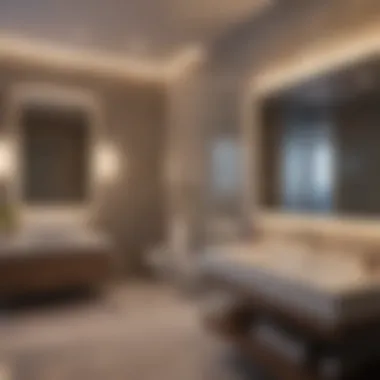
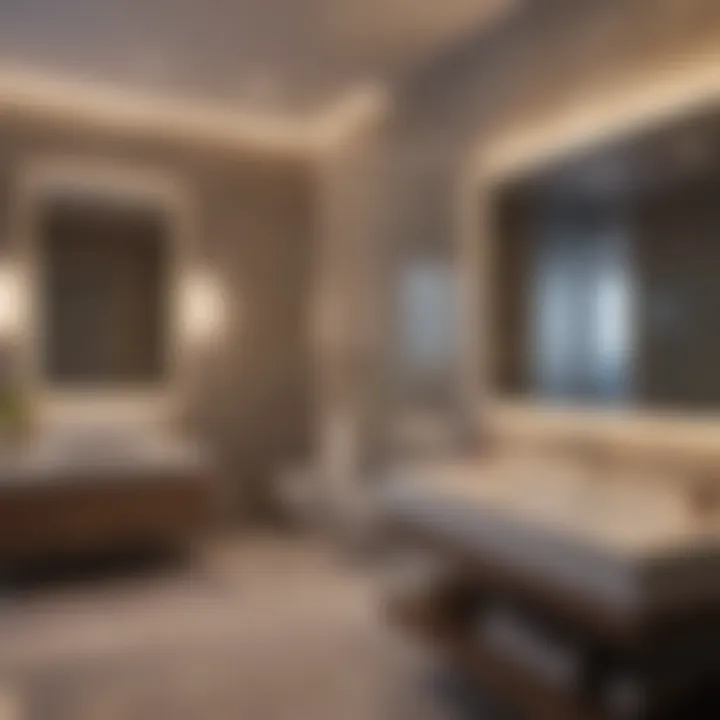
- Transom Windows: These small windows above the main ones allow additional light without compromising privacy.
- Bay or Bow Windows: Extending outward can create a lovely nook while maximizing light.
- Skylights: Ideal for smaller bathrooms, they bring in direct sunlight and can create a sense of spaciousness.
Using Mirrors to Reflect Light
Mirrors are often the unsung heroes of bathroom design. When strategically placed, they can amplify the effect of natural light, creating an illusion of a larger and brighter space. A well-placed mirror can bounce sunlight around the room, softening shadows and filling in darker corners.
A few strategies include:
- Opposite Windows: Place a mirror opposite a window to reflect light directly back into the room. This trick can double the amount of light that feels present.
- Layering: Using mirrors of various shapes and sizes can enhance the visual complexity of the space and allow for a playful interaction with light.
- Decorative Touch: Choose mirrors with unique frames that complement your decor while serving their reflective purpose. A vintage frame can add charm, while a sleek, modern design can enhance minimalism.
A well-placed mirror can make a room feel more spacious and bright, transforming a simple design into a luxurious experience.
Layering Light for Ambiance
Creating a sanctuary in your bathroom isn't just about aesthetics; it’s about how the light interacts with the space as a whole. The art of layering light involves combining different types of lighting to create a balanced and inviting atmosphere. When done right, it elevates the functionality and beauty of your bathroom, turning it into a place where one can unwind.
Think of lighting as the backdrop to your day-to-day rituals. It sets the tone for relaxation or refreshment, influencing how you feel in the space. Layering enables you to adjust your lighting according to your mood and needs. Moreover, it lets you showcase architectural features, accessories, and beautiful fixtures, making the bathroom not just practical but also pleasing to the eyes.
Combining Light Sources
Combining light sources is the first step in layering. This means integrating ambient, task, and accent lighting to craft a cohesive look. Here's a closer examination of these types:
- Ambient Lighting: This is the general illumination, giving a comfortable level of brightness. Think ceiling fixtures or recessed lights that fill the room with a soft glow. Position these strategically to lighten every corner, easing any hard shadows that may create a gloomy feeling.
- Task Lighting: Here’s where function meets light. Task lighting is essential around mirrors and vanities, ensuring you’ll be able to carry out daily routines without squinting. That’s where wall sconces or LED strip lights can shine, literally. Install them on either side of the mirror for balanced lighting.
- Accent Lighting: This adds a dash of flair and emphasizes particular design elements. Use it to highlight artworks or architectural details. For example, LED spotlights directed towards a beautiful tile pattern can turn an ordinary wall into a captivating focal point.
While weaving these lights together, consider how they work collectively. A mixture of types will create depth and texture, rather than having a flat, homogeneous glow.
Dimming Options for Mood Control
When focusing on ambiance, dimming options hold immense power. They allow you to control the intensity of your lighting at any point of the day. A brighter light can be invigorating and energizing for morning routines, while softer, warmer hues can create a soothing environment for evening baths.
- Smart Dimmers: Technology can aid this process significantly. Smart dimmers can be programmed to change with your routine. You can set them up to gradually lighten in the morning or shift to a warm, cozy ambience as you unwind in the evening.
- Traditional Dimmer Switches: If smart home gear isn’t your cup of tea, traditional dimmers can also work wonders. These are easy to install and give you control over brightness without modifying the existing fixtures.
In addition, consider color temperature when dimming. Warmer tones tend to create a more relaxed atmosphere, while cooler tones can feel crisp and clean. The right combination can transform ordinary moments into serene experiences.
"Lighting not only affects how we see things but also how we feel in a space."
By layering light sources and offering varied dimming options, you elevate the experience of your bathroom, ensuring that it serves both as a functional space and a personal retreat.
Color Temperature and Its Impact
The choice of lighting in any space has an unmistakable influence on ambiance and functionality, and bathrooms are no exception. Color temperature, measured in Kelvins (K), plays a pivotal role in setting the mood of your sanctuary. This choice has implications for how colors appear, the perceived size of the space, and even the psychological impact on those who use it. A swift overview shows that color temperature can be broadly categorized into warm and cool tones, each providing distinct advantages and evoking different feelings. Understanding its nuances not only enhances aesthetic appeal but also makes everyday tasks more enjoyable and efficient.
Warm vs. Cool Light
When it comes to selecting between warm and cool light, the context is key. Warm light typically falls within a range of 2700K to 3000K. This inviting atmosphere is reminiscent of the golden hue of sunrise or the soft glow of a cozy fireplace. It works wonders in creating a relaxing environment, making it a popular choice for bathrooms intended for unwinding after a long day. Opting for warm bulbs can indeed bring a soothing effect, aligning with the idea of a calming retreat.
On the other hand, cool light spans from 3500K to 5000K. This kind of light is akin to daylight, creating a crisp and revitalizing environment. Bathrooms designed for functionality, where precise grooming tasks take place, benefit from cool lighting. Such illumination aids in recognizing colors accurately, which is particularly significant when applying makeup or shaving.
In short, squaring away your preference between warm and cool light hinges on how you envision your bathroom's purpose. Do you desire a tranquil escape or a space that invigorates you? Based on this, decisions about fixtures and colors should closely follow.
Color Rendering Index (CRI)
Equally important as color temperature is the Color Rendering Index (CRI), which measures how well a light source reveals the true colors of objects. It ranges from 0 to 100, with higher values indicating that colors appear more natural. For bathrooms—where accurate color perception is vital—a CRI rating of 90 or above is desirable. Think about it: an inaccurate light source could lead to makeup disasters or mismatched wardrobe choices, all stemming from the failure to recognize colors correctly.
You may ponder how this plays into your fixture selection. Many LED bulbs nowadays tout high CRI specifications. Seeking out options boasting CRI ratings of 90 or greater can serve you well as you curate your bathroom lighting.
"For a bathroom that functions as both a workplace and a sanctuary, attention to color temperature and CRI is non-negotiable. These elements create not just a beautiful space but a highly functional one."
In summary, the impact of color temperature and CRI is vast and multifaceted. Each component shapes your experience, whether you're starting your day or winding down in the evening. By carefully considering these aspects, you own a significant piece of the puzzle in crafting the sanctuary that is your bathroom.
Trends in Bathroom Lighting
In today’s ever-evolving design landscape, keeping up with the latest trends in bathroom lighting is more important than ever. As homeowners design their personal sanctuaries, lighting plays a pivotal role in balancing aesthetics and functionality. A well-lit space can transform an ordinary bathroom into a soothing retreat. Incorporating current trends allows for an easy upgrade, providing fresh ideas that not only amplify style but also enhance the overall experience. Whether your aim is to add sophistication or create a contemporary vibe, understanding these trends helps in making informed choices.
Vintage and Retro Styles
Vintage and retro styles are making a significant comeback in bathroom lighting design. These nostalgic elements hark back to an era where craftsmanship was celebrated, and intricate details adorned common spaces. Fixtures reminiscent of the mid-century can seamlessly marry old-school elegance with modern practicality.
Some features to consider include:
- Pendant Lights: These can make a strong design statement and are perfect for adding character.
- Antique Finishes: Copper or brass elements can add warmth, especially when contrasted with cooler tiles and fixtures.
- Art Deco Patterns: Geometric shapes in light fixtures or glass patterns can bring a trendy vibe while being classic at the same time.
Incorporating these styles can provide a visually stimulating environment, connecting the present with the past.
Minimalism and Simplicity
Minimalism continues to reign supreme in modern design. The clean lines and understated elegance of minimalist lighting resonate well with contemporary design philosophies. This style emphasizes functionality without sacrificing beauty, resulting in a serene, clutter-free bathroom ambiance.
When embracing minimalism, consider these aspects:
- Streamlined Shapes: Choose fixtures that have a simple yet striking appearance, such as linear LED lights.
- Neutral Tones: Whites, grays, and blacks offer a sleek backdrop for more prominent design elements.
- Integrated Lighting: LED strip lights or recessed fixtures can enhance simplicity while maintaining a modern aesthetic.
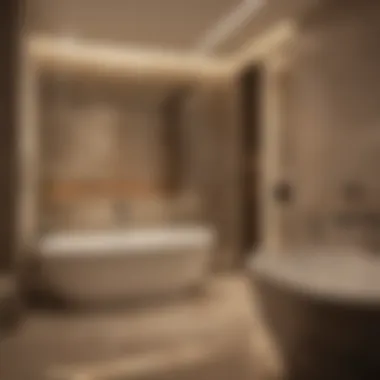
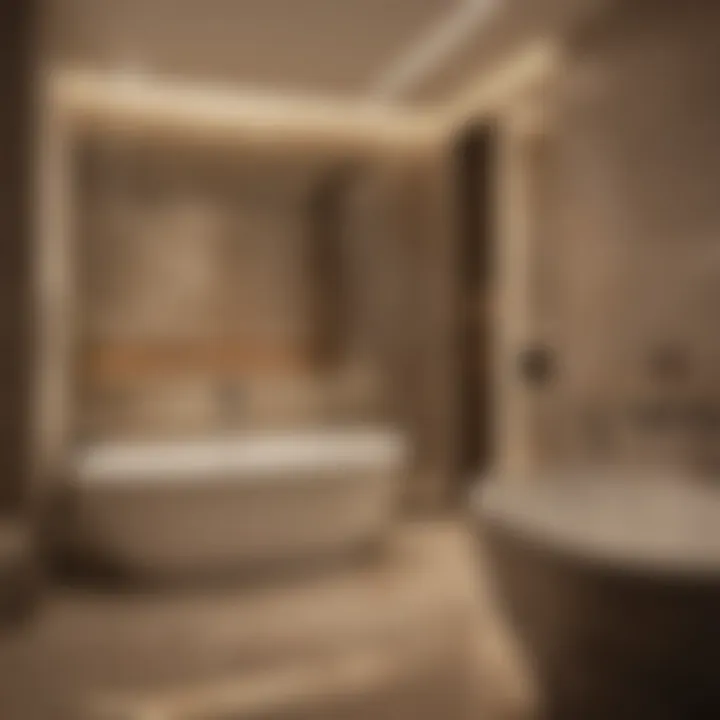
Embracing minimalism creates a calming atmosphere—perfect for a bathroom designed for relaxation.
Smart Lighting Solutions
With technology advancing at a lightning pace, smart lighting solutions are becoming increasingly popular. These tools not only improve functionality but also offer customization that meets the needs of a modern lifestyle. Homeowners can now control lighting remotely, adjust brightness, or set specific moods—all with a simple tap on their smartphones.
Key features of smart lighting include:
- Voice-Controlled Systems: Imagine walking into your bathroom, hands full, only to command the lights on with your voice.
- Programmable Settings: Create daily routines where your bathroom transitions from soft morning light to brighter, energizing tones as the day goes on.
- Mood Enhancement: Colors can shift according to your desired ambiance—turn on soft blues for a relaxing soak or bright whites when prepping for the day.
Integrating smart solutions not only enhances convenience but transforms your bathroom into a personalized sanctuary, tailored to your unique lifestyle.
As trends continue to shift and evolve, it’s essential to stay informed. Understanding the latest in bathroom lighting can lead to thoughtful decisions that not only beautify your space but also improve its functionality, offering a cohesive sanctuary that reflects your style.
Addressing Common Challenges
When it comes to bathroom lighting, one size certainly doesn’t fit all. Every bathroom has its peculiarities, and figuring out how to make the most of what you have can be a bit of a puzzle. In this section, we’re tapping into the heart of the matter—how to overcome some of the common challenges that arise when designing your bathroom lighting. Addressing these issues not only improves functionality but also elevates the overall aesthetic of your space. You want a setup that doesn’t just shine a light, but creates a pleasant atmosphere to start and end each day.
Dealing with Limited Space
Limited space in a bathroom often complicates the installation of lighting fixtures. The trend today leans toward using clever solutions that blend functionality with style. When working with tight quarters, opting for wall-mounted fixtures can save a considerable amount of floor space. Wall sconces larger than your typical pendant can make a significant impact without cluttering your bathroom.
For example, consider integrated LED strips in mirrors or cabinetry; they not only illuminate effectively but also make spaces feel larger than they are. If you have a tiny bathroom, a soft, well-distributed ambient light can work wonders; using light-colored shades can amplify this effect further.
Here are some tips for maximizing lighting in smaller bathrooms:
- Use glass or acrylic fixtures to minimize a bulky feel.
- Consider recessed lighting, which can provide a clean look without protruding.
- Make use of vertical space by installing fixtures higher on the wall, drawing the eye upward.
- Mirrors can create an illusion of depth, specifically if lights are placed behind them.
Sometimes, simply straying from traditional fixture sizes yields surprising results. Opting for elongated shapes or minimalist designs can make a small area feel cozy yet spacious.
Eliminating Shadows in Task Areas
Shadows can be a real stumbling block, especially around areas where precision is key, like the sink or mirror. Eliminating shadows helps create a space where you can confidently manage tasks such as shaving or applying makeup. Positioning lights effectively is essential here. Task lighting should ideally be placed at eye level. When lights are located above or off to the side, you can end up with shadowy patches that are less than flattering.
Here are a few strategies to illuminate those task-heavy zones:
- Install fixtures on either side of the mirror—this can cut down shadow drastically.
- Using light bulbs with a higher Color Rendering Index (CRI) can help ensure that colors appear more accurate, which is especially useful when choosing clothing or makeup.
- Experiment with adjustable fixtures that allow you to control the light direction, giving you flexibility depending on what you’re working on.
In essence, the way you set up your lighting in your bathroom can greatly affect its usability. Picking the right spots and fixtures to target both function and ambiance will create a haven where you can enjoy your daily routines without frustration. With careful planning, even the quirkiest bathrooms can shine.
Stylizing with Decorative Elements
When it comes to bathroom design, the idea of stylizing with decorative elements isn’t just about aesthetics; it plays an essential role in creating a space that feels like a sanctuary. The bathroom is often viewed as a personal retreat. Consequently, merging form and function through decorative lighting is crucial. Unique elements can transform an everyday bathroom into a visually appealing oasis, all while providing the necessary illumination for daily tasks.
One of the key benefits of integrating decorative lighting elements is the opportunity to express personal style. Unlike other areas in the home, the bathroom presents a compact canvas where homeowners can experiment with design choices without overwhelming the space. Decorative fixtures, such as artistic pendant lights or distinct wall sconces, can serve as statement pieces that draw the eye and set the overall mood.
However, it’s essential to consider the practical implications of these design choices. While focusing on aesthetics, the lighting must also serve its primary function. This duality requires a careful selection process to ensure that beauty doesn’t overshadow utility. Therefore, striking a balance between decorative beauty and adequate illumination is paramount.
Integrating Art and Sculptural Pieces
Incorporating art and sculptural pieces into bathroom lighting is a savvy way to elevate the space. Think outside the box: instead of plain fixtures, consider sculptural lighting options that can act as both source of light and artistic focal point.
For instance, a sculptural chandelier can be a real showstopper. The way it diffuses light can create enchanting shadows on the walls, enveloping the space in warmth and character. A well-placed piece of bathroom art, such as a framed painting or a selective arrangement of decor, can complement the ambient light, enhancing the overall aesthetic.
Additionally, homeowners can look into installations that mimic natural forms. Nature-inspired designs, like those featuring organic shapes or textures, can contribute to a calming atmosphere, thus enhancing the sanctuary feel. However, one must ensure these pieces resonate with the overall theme of the bathroom; an eclectic piece in a minimalist setting might seem out of place.
Utilizing Shade and Color for Effect
Shade and color wield incredible power over the perception of a space. In a bathroom, strategically using shades can dramatically alter the mood. For instance, softer, warmer tones tend to promote a relaxing ambiance, while sharper colors can invigorate the senses, ideal for a refreshing start to the day.
Consider installing colored light bulbs in fixtures or utilizing colored shades that can filter the light. The effect of colored lighting can transform the environment—from serene whites and soft yellows for relaxation to vibrant blues and greens for energy.
Moreover, layering colors through different light fixtures—like a warm glow from vanity lights complemented by cooler hues from accent lighting—can create a dynamic and engaging atmosphere. That interplay can soothe or energize, depending on the time of day or simply the homeowner's mood.
"You don’t have to break the bank to create a stunning bathroom sanctuary; sometimes, a simple change of light can work wonders."
Finding the right blend of shades and colors is pivotal, and understanding personal preferences will ensure the bathroom truly reflects the homeowner's essence. Ultimately, decorative elements shape not only the look but also the feel of the space, making it a truly personal sanctuary.
Photographic Inspiration
Photographic inspiration serves as a powerful resource in the context of designing bathroom lighting. In many respects, images can convey what words simply cannot. Visual representations of lighting styles and implementations showcase the potential of light within a space, offering concrete examples that homeowners can relate to. Through rich imagery, one can grasp how different fixtures interact with various aesthetics while enhancing functionality.
Key Elements of Photographic Inspiration
- Visual Storytelling: Each photograph tells a story, revealing how lighting can transform an ordinary bathroom into a tranquil retreat. From intimate ambient settings to bright task-focused designs, seeing these captured moments helps one to visualize possibilities.
- Design Diversity: The gallery of images portrays a range of styles—from vintage charm to sleek modernity—allowing readers to explore the vast options available. This variety encourages innovation and inspires unique ideas tailored to individual tastes.
- Real-world Applications: Photographs of real bathrooms in real homes showcase successful implementations of design concepts. They serve as proof that ideas can be translated from paper to reality, bridging the gap between inspiration and execution.
"A picture is worth a thousand words, especially when aiming to illuminate the hidden beauty within a space."
Benefits of Utilizing Photographic Inspiration
- Enhanced Decision-Making: Observing how lighting choices affect the overall atmosphere can guide homeowners in making more informed decisions. It becomes clearer how certain light fixtures or arrangements can impact their bathrooms.
- Encouragement for Experimentation: Browsing through a collection of diverse designs ignites creativity. Homeowners may feel inspired to mix and match elements from different photographs, creating something distinctive for their own sanctuary.
- Practical Guidance: Photographs often highlight practical considerations, such as positioning light fixtures to minimize shadows or enhance features like tile textures. These subtle details can prove invaluable in the decision-making process.
Considerations for Using Photographic Inspiration
While images can be immensely helpful, it’s essential to remember a few things:
- Context Matters: Not every lighting design will fit every bathroom. What works in a spacious layout might not suit a smaller one. It’s crucial to evaluate how well a concept will translate into the specific space one has.
- Color and Finishes: Lighting can significantly change perception. Photographs may have varied color temperatures and materials that could mislead one's expectations. Be sure to consider the actual effects of different bulbs and materials in your space.
- Budget Constraints: High-end lights captured in professional photographs can inspire but may also intimidate if the costs are not feasible. Therefore, it’s important to find similar styles within budget, ensuring the design remains achievable.



